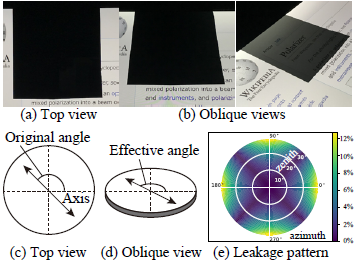Polarized Non-Line-of-Sight Imaging
Kenichiro Tanaka1, 2,
Yasuhiro Mukaigawa1,
Achuta Kadambi2,
1 Nara Institute of Science and Technology (NAIST)
2 University of California, Los Angeles (UCLA)
CVPR 2020: [Open Access (PDF)]
[arXiv preprint]
[Project Page at UCLA Visual Machines Group]
Media
[UCLA Samueli Newsroom]Researchers at @UCLA and @NAIST_MAIN_EN have developed a camera that can see around corners - and could someday be applied to help #AutonomousVehicles avoid crashes, enable doctors to see around organs, and more. Learn more at @UCLAengineering: https://t.co/6WV3A4zq8P pic.twitter.com/pf144PEbMn
— Association for Computing Machinery (@TheOfficialACM) July 22, 2020
Abstract
This paper presents a method of passive non-line-of-sight (NLOS) imaging using polarization cues. A key observation is that the oblique light has a different polarimetric signal. It turns out this effect is due to the polarization axis rotation, a phenomena which can be used to better condition the light transport matrix for non-line-of-sight imaging. Our analysis and results show that the use of a polarization for NLOS is both a standalone technique, as well as an enhancement technique to boost the results of other forms of passive NLOS imaging. We make a surprising finding that, despite 50% light attenuation from polarization optics, the gains from polarized NLOS are overall superior to unpolarized NLOS.
Results
Our method recovers better images comapred to unpolarized NLOS.

Contributions
- We bring the polarizer's effective angle theory to the computer vision field. The polarizer's transmitting/blocking axis depends on both zenith and azimuth angle of the light ray, which conveys rich angular information.
- We demonstrate that the polarization cues are able to improve the conditioning of the light transport for passive NLOS imaging without scene modifications.
- We demonstrate that the same polarization cues also improve other passive NLOS approaches, including those that use partial occluders.
Scope
While polarization is a fresh signal for use in NLOS imaging, the quality of passive NLOS (after polarization enhancement) does not approach that of active methods, which have been shown to obtain extremely high-fidelity reconstructions. However, our polarization enhancement is fundamentally more general than the results we present here. A future extension details how the proposed technique could apply to active NLOS imaging, covered in the appendix.
Frequently Asked Questions
- What is the effective angle of the polarizer?
- Is the reflected light polarized?
- Is the the scene polarized?
- Is this superior than using specular wall?
- Isn't the observation dark?
It is an angle-dependent effect of the polarizer. Light leakage occurs when the light ray is oblique to the polarizer. The figure shows pictures of the same scene from top and oblique views. While the LCD monitor is invisible from top view (a), it is slightly visible from certain oblique views depending on the zenith and azimuth angles (b). (c) The original angle of polarizer from top view. (d) The effective angle from oblique view. The polarizer axis is slightly declined. (e) Light leakage pattern of crossed polarizers from oblique view. This effect is angle dependent, therefore it can be used for analyzing NLOS observations.

Yes, all reflections are partially polarized. Especially, when the camera is at the special angle (so called Brewster angle), the reflected light is perfectly linear polarized.
No, the scene is not polarized. Although the scene is unpolarized, the reflected light off the wall is pertially polarized.
Our method always improves the performance for all reflection parameters of the wall. You can compbine our polarization technique to other techniques including putting a partial occluder and using specular wall material.
Despite the low light efficiency due to light cut off at the polarizer, the polarization cues can improve the conditioning. This is a suprising finding.